How to Choose Between a Rottweiler and a Doberman for Protection
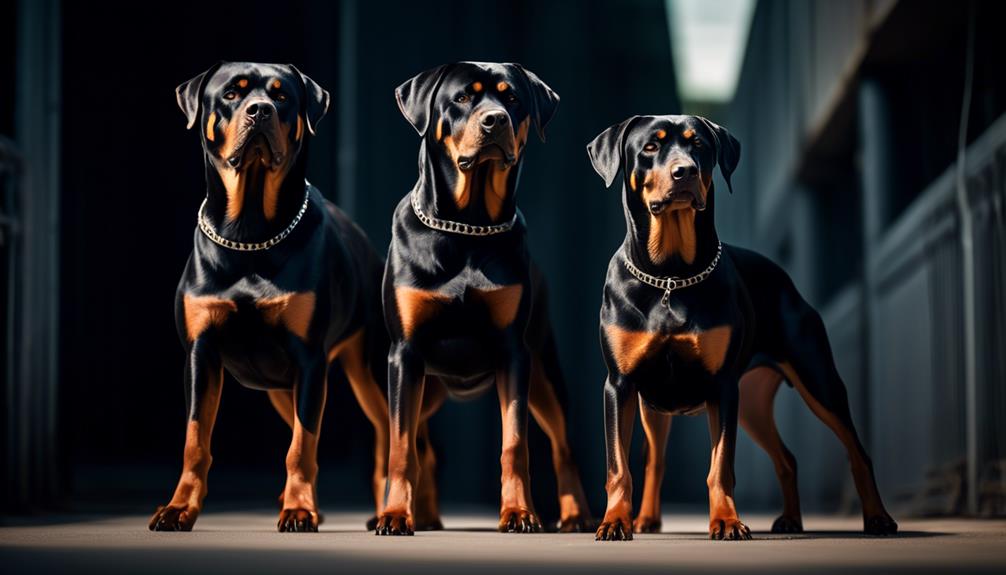
Choosing between a Rottweiler and a Doberman for protection depends on personal preferences and specific needs. Both breeds are known for their protective instincts and formidable presence.
Key Takeaways
- Both Dobermans and Rottweilers are known for their protective instincts, making them suitable choices for protection purposes.
- Dobermans require more exercise compared to Rottweilers, so individuals with an active lifestyle may lean towards this breed.
- Rottweilers are more adaptable to varying climates, making them a good choice for people living in different regions.
- Dobermans tend to form a close bond with one person, while Rottweilers can bond with multiple individuals, allowing for flexibility in the ownership dynamic.
Breed Similarities and Differences
The Doberman and Rottweiler share similar protective instincts, but they also have distinct differences in terms of exercise needs, adaptability to climates, and bonding tendencies.
Both breeds, known for their roles as guard dogs, are intelligent and make excellent working dogs. However, the Doberman generally requires more exercise compared to the Rottweiler. With their high energy levels, Dobermans need regular physical activity to stay mentally stimulated and prevent behavioral issues.
On the other hand, Rottweilers are generally more adaptable to varying climates due to their muscular build. They’re better equipped to handle extreme temperatures than Dobermans, which are more sensitive to heat and cold.
In terms of bonding tendencies, Dobermans tend to form a close and loyal bond with one person, while Rottweilers have the potential to form strong bonds with multiple individuals. It’s crucial to note that both breeds can experience separation anxiety if not properly trained and socialized from a young age.
To ensure their protective instincts are channeled appropriately, consistent and proper training is essential for both Dobermans and Rottweilers.
Temperament and Personality Traits
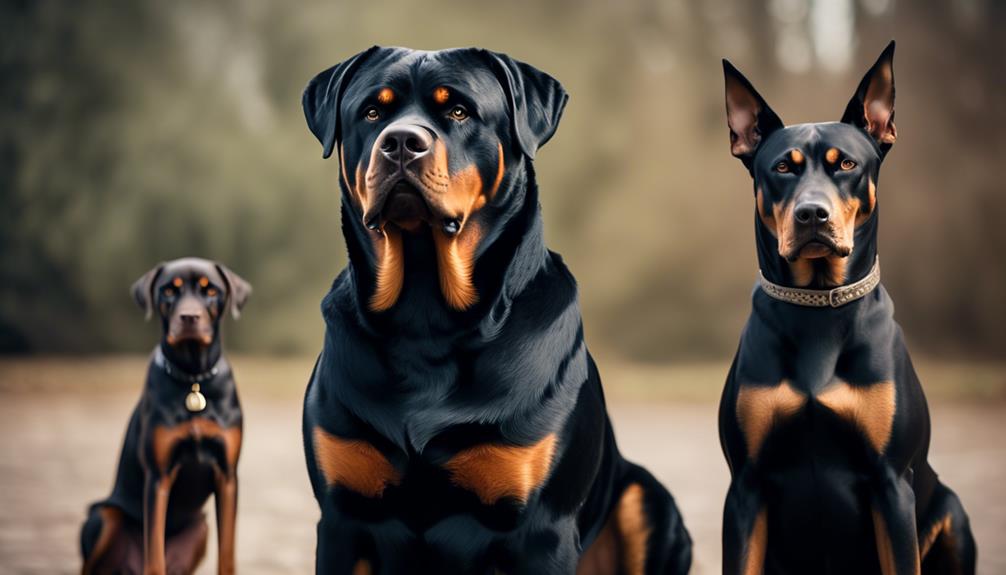
Known for their loyalty, protectiveness, and intelligence, Dobermans and Rottweilers possess distinct temperament and personality traits that contribute to their roles as effective guard dogs. While both breeds are highly intelligent and make excellent protectors, there are key differences in their temperaments that may influence your choice in the context of protection.
Dobermans are known for their high energy levels and need for mental stimulation. They are active dogs that require regular exercise to keep them physically and mentally engaged. Their intelligence and eagerness to please make them highly trainable, and they excel in tasks that require focus and obedience. With their alertness and fearlessness, Dobermans are natural guard dogs. They can be wary of strangers and are quick to protect their families and property.
On the other hand, Rottweilers are typically calmer and more laid-back compared to Dobermans. They still require regular exercise but are generally more moderate in their exercise needs. Rottweilers are known for their loyalty and affectionate nature towards their families. They are confident dogs that exhibit a calm and steady temperament. Rottweilers are also alert and fearless, making them reliable guard dogs.
To better understand the temperamental and personality differences between Dobermans and Rottweilers, refer to the table below:
| Traits | Dobermans | Rottweilers |
|---|---|---|
| Energy Level | High | Moderate |
| Trainability | Highly trainable | Highly trainable |
| Temperament | Alert, fearless, protective | Confident, calm, protective |
| Exercise Needs | High exercise requirements | Moderate exercise requirements |
| Affection towards | Affectionate towards their families | Affectionate towards their families |
| their families | ||
| Guarding Instincts | Strong | Strong |
Considering the temperament and personality traits outlined above, it is important to choose the breed that aligns with your lifestyle and requirements for protection. Whether you prefer the high energy and intense focus of a Doberman or the calm and steady nature of a Rottweiler, both breeds can serve as effective guard dogs in the right hands.
Exercise and Training Needs
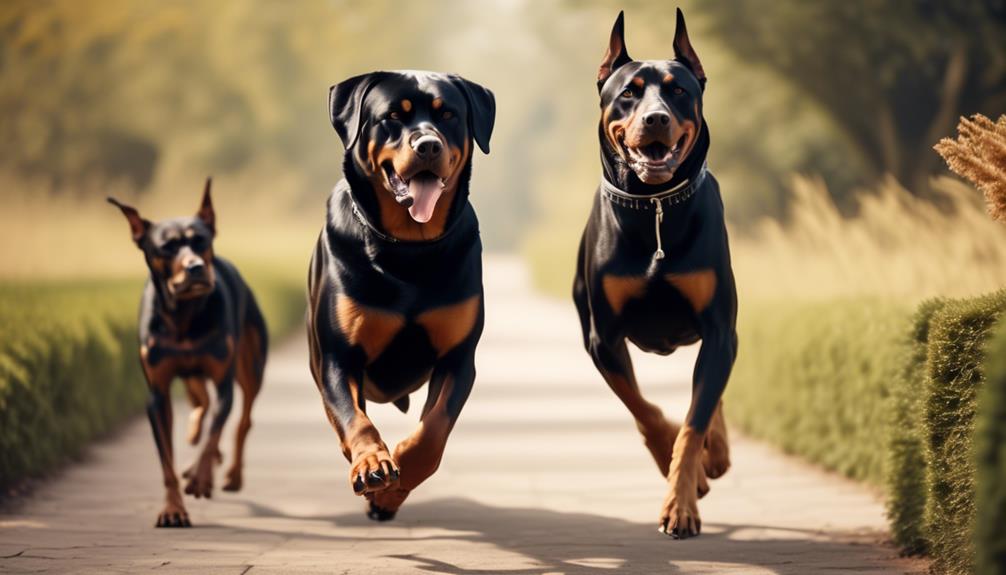
After considering the temperament and personality traits of Dobermans and Rottweilers, it’s essential to understand their exercise and training needs to ensure their overall well-being as effective guard dogs.
Both Dobermans and Rottweilers are highly intelligent dogs that require regular exercise and mental stimulation. However, there are some differences in their exercise and training requirements.
Dobermans tend to have higher energy levels than Rottweilers and need intense exercise of at least two hours a day to keep them physically and mentally stimulated. They’re highly social dogs that thrive on human interaction, so activities like obedience training and agility courses can provide the mental stimulation they need. Regular exercise is crucial for Dobermans to prevent behavioral issues and promote their well-being.
On the other hand, Rottweilers also require daily exercise, but they generally have lower energy levels compared to Dobermans. They need at least an hour of intense exercise to maintain their physical and mental well-being. Rottweilers are powerful dogs with a strong prey drive, so activities like fetch, hiking, and long walks can help them expend their energy in a positive way.
Size and Physical Characteristics
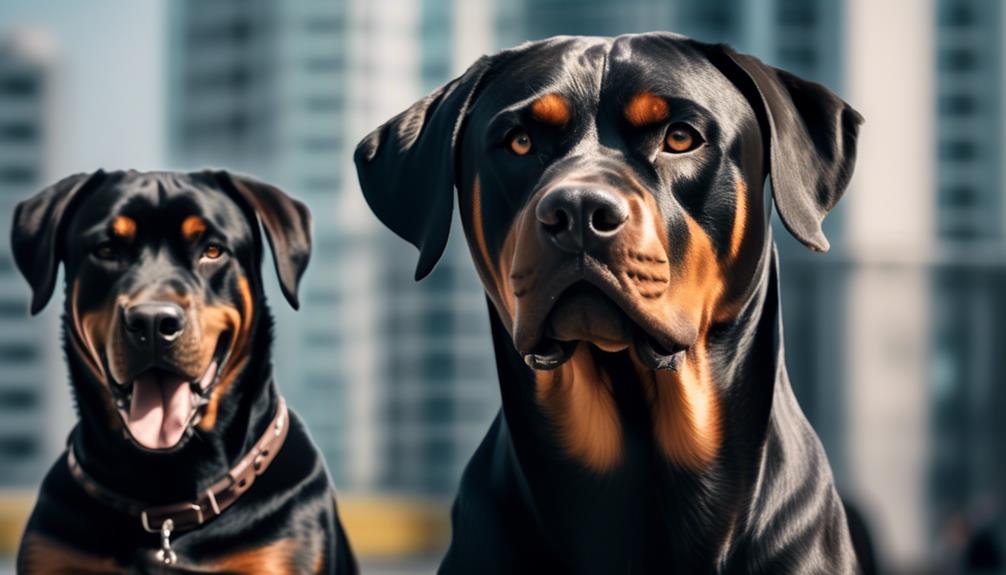
Size and physical characteristics play a significant role in differentiating between Dobermans and Rottweilers. When considering these two breeds as protection dogs, it’s important to understand their differences in size and appearance. Here are some key facts to consider:
- Male Dobermans stand around 24 to 28 inches at the shoulder, while male Rottweilers average around 24 to 27 inches at the shoulder.
- Rottweilers can weigh up to 130 pounds, while Dobermans weigh around 85 to 99 pounds.
- Dobermans have well-defined, slender waists compared to Rottweilers, who are heavier and have a more muscular build.
- Rottweilers have a height range of 22 to 27 inches, while Dobermans are 24 to 28 inches tall.
- Both breeds have a distinctive black and tan coloration, but Dobermans come in various colors like blue, red, tan, brown, white, and black with rust-colored markings.
Understanding these variations in size and physical characteristics can help you make an informed decision when choosing between a Doberman and a Rottweiler for protection. Whether you prefer a slightly larger and more muscular dog like the Rottweiler or a sleeker and more agile dog like the Doberman, both breeds are highly intelligent and make excellent family pets.
It’s also important to note that both Dobermans and Rottweilers typically have their tails docked, a common practice among these breeds.
Family Compatibility and Socialization

Socialization and family compatibility are crucial factors to consider when choosing between a Rottweiler and a Doberman for protection. Both breeds require early socialization with family members and other pets to ensure a harmonious family environment.
Early exposure to various social situations and environments is essential for the development of well-adjusted and confident dogs. The American Kennel Club acknowledges the importance of properly training and socializing both Rottweilers and Dobermans to help them become adaptable members of the family.
Both breeds can be compatible with families, but consistent socialization and positive experiences are necessary to shape their behavior. Patience, understanding, and positive reinforcement play a key role in helping Rottweilers and Dobermans become well-socialized and adaptable. It’s important to create a nurturing and supportive environment for these breeds, as they require a strong bond with their owners.
Health Considerations and Lifespan
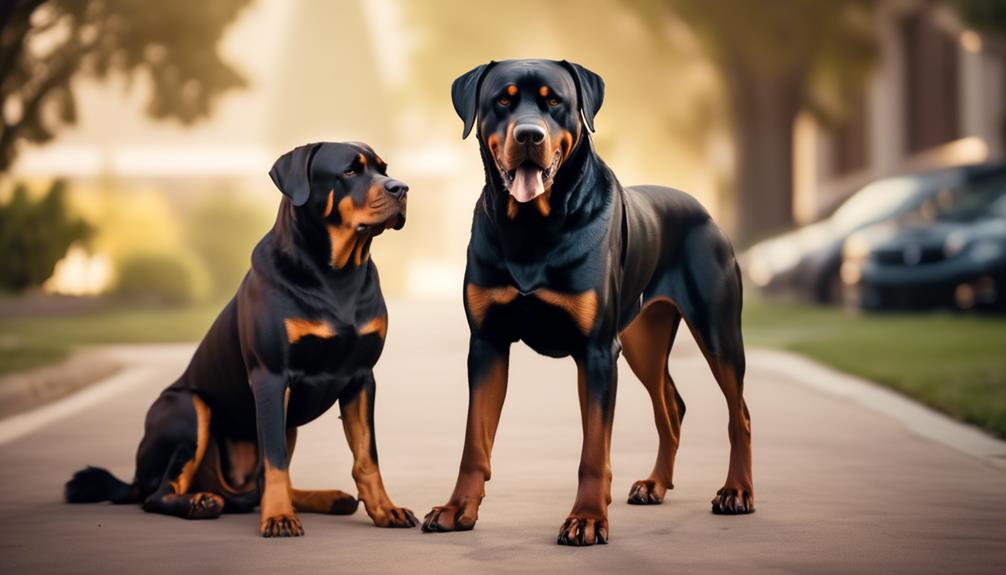
When considering the health considerations and lifespan of Rottweilers and Dobermans, it’s important to note that both breeds are prone to certain health issues. Here are some key points to consider:
- Lifespan: Dobermans have an average lifespan of 10-12 years, while Rottweilers typically live 8-10 years. It’s important to be aware of these lifespans when making a decision about which breed is right for you.
- Health issues: Both breeds are susceptible to health issues such as hip dysplasia and heart disease. Regular veterinary check-ups and proper care can help identify and manage these conditions.
- Exercise and mental stimulation: Dobermans require regular exercise and mental stimulation to maintain good health. They’re an active breed that thrives on physical activity and mental challenges.
- Temperament: Rottweilers are generally more laid back compared to Dobermans. However, both breeds need to be properly trained and socialized to ensure they’re well-behaved and reliable protectors.
- Grooming: Both breeds have a double coat that requires regular grooming. This includes brushing to prevent matting and shedding, as well as occasional baths.
Making the Final Decision: Which Breed Is Right for You?
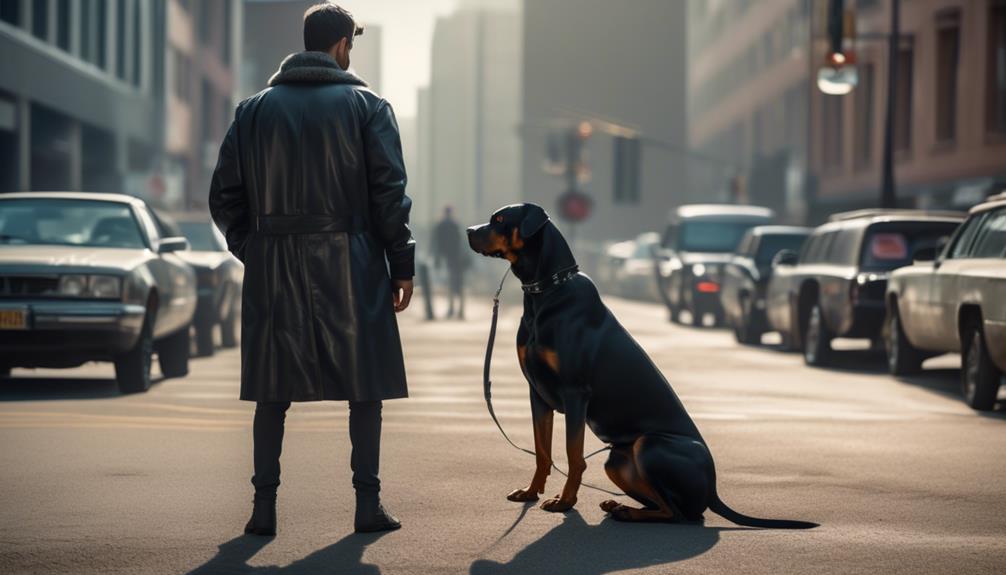
To make the final decision on which breed is right for you, consider the temperament, exercise needs, and lifespan of both Dobermans and Rottweilers. Dobermans are known for their vigilance and alertness, making them excellent protection dogs. They require more exercise and mental stimulation compared to Rottweilers, making them suitable for active individuals or families.
On the other hand, Rottweilers have a calmer demeanor and are less territorial. They adapt well to families with younger children and have an intimidating appearance that can deter intruders. When it comes to lifespan, Dobermans tend to live longer than Rottweilers.
To help you visualize the differences between the two breeds, here is a comparison table:
| Breed | Doberman | Rottweiler |
|---|---|---|
| Temperament | Vigilant and alert | Calm and laid back |
| Exercise Needs | High exercise requirements | Moderate exercise requirements |
| Lifespan | 10-13 years | 8-10 years |
Consider your lifestyle, preferences, and the specific needs of your household when making the final decision. Both breeds are people-oriented and can provide excellent protection, so it ultimately boils down to what aligns best with your circumstances. Ensure that you provide proper training, socialization, and care for whichever breed you choose.
Frequently Asked Questions
Which Is Better Guard Dog Doberman or Rottweiler?
A Doberman and a Rottweiler both make excellent guard dogs, but the choice depends on individual preferences. Dobermans require intense exercise and mental stimulation, while Rottweilers are more laid-back. Proper training and socialization are crucial for both breeds.
What Is the Best Guard Dog?
The best guard dog depends on the specific needs and preferences of the individual or family. Factors to consider include temperament, size, exercise requirements, and training. It is recommended to consult with a professional to make an informed decision.
Is Doberman a Good Protector?
A Doberman is a good protector due to its protective instincts, intelligence, and loyalty. They require consistent training and exercise to thrive. Rottweilers also have protective instincts and are powerful, but may require more socialization and training.
Do Rottweilers Make Good Personal Protection Dogs?
Rottweilers can make excellent personal protection dogs with proper training. Their loyal and fearless temperament, combined with their intelligence and responsiveness to training, make them a reliable choice. However, it’s important to consider their exercise needs and breed-specific laws when choosing the right breed for your lifestyle.









